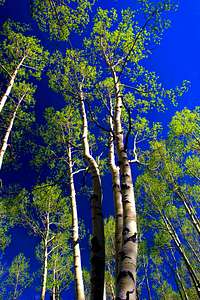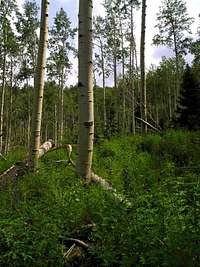|
|
Area/Range |
|---|---|
|
|
37.62946°N / 112.85431°W |
|
|
Hiking |
|
|
10662 ft / 3250 m |
|
|
Overview
Information: Cedar Breaks
Cedar Breaks National Monument sits on top of the Colorado Plateau on Cedar Mountain and is surrounded by Dixie National Forest. The Monument is a high alpine spectacle offering cool summer visits and winter recreation. Those that look no farther than the red rock hoodoos will say that the Monument is just like Bryce Canyon National Park, only smaller. Those that say that are wrong. Cedar Breaks offers many things that Bryce Canyon does not. To start with the colors and hues of the rock surpass that of Bryce making for wonderful photo opportunities. The area is not as hectic as Bryce, where bus loads of people are unloaded throughout the day due to marketing by Ruby's Inn. Cedar Breaks has a rustic old cabin constructed by the (CCC) Civilian Conservation Corps in 1937 which is used for the Cedar Breaks Visitor Center. To me, that is far more charming and ideal than a fancy big building. Most important of all is the hiking, it is far more interesting than hiking in Bryce Canyon.
Amphitheater of Hoodoos - There is one giant amphitheater filled with fins, windows and spires which is three-miles long and more than 2000 feet deep. The erosion at Cedar Breaks is faster than that at Bryce and perhaps that is why the colors are more exaggerated.
Trails - The trails that the park advertises are above the rim, but there are some outstanding routes in and near Cedar Breaks that you can do that drop below, some will even take you down to the hoodoos themselves. Ashdown Gorge is one of my favorite canyons ever and it starts right at the edge of the park and descends near the bottom of the hoodoos then exits at Highway 14. The park handout describes the Alpine Pond Trail and the Spectra Point Trail. Both are fairy easy family hikes, but there is so much more there to explore.
Cedar Breaks Hiking
Spectra Point-Ramparts Trail: Depending on how far you want to go you can do a 2 to 4 mile round-trip hike. (You can actually hike beyond this) It skirts the rim and takes hikers to some beautiful and ancient Bristlecone Pine trees and a different view of the amphitheatre.
Alpine Pond Trail: This 2-mile trail goes past delicate white columbines and a large selection of other wildflowers as it leads to an alpine pond.
Winter Recreation - The high point at the monument is 10,622 feet and the low point is 8,100, so the area does get a lot of snow. In the winter most of the roads are closed but after the snow accumulates winter recreation begins and you can cross-country ski, snowshoe or snowmobile into the park and on marked trails within the park. The park marks the trails so look forward to snowshoes and cross-country trails. The routes run from the north park boundary and then along the rim. The one hiking trail that is marked for cross-country skiing is the Alpine Pond Trail. Once there is enough snow on the roads then the snowmobile trails will open, but motorized vehicles must stay on marked trails only when within the park boundaries.
Ranger Programs - Free geology talks go on throughout the summer season, Monday through Friday at 10am and 2:30pm at Point Supreme. To do a walk/hike with a ranger meet on Saturday or Sunday at 10am at the Spectra Point Trailhead in the visitor center parking lot.
Red Tape and Getting There
Directions - Cedar Breaks is 23 miles east of Cedar City and 45 east of the Kolob Canyons section of Zion National Park, 3 miles south of Brian Head Ski Resort and 45 miles from Mt. Carmel Jct, on the east side of Zion National Park. From Las Vegas head to Cedar City first, then take Highway 14 to Highway 148 which will take you to the Monument. If you are coming from Arizona take Highway 89 north to Mt. Carmel Jct., then turn west on Highway 14, then right on Highway 143. If you are driving south on I-15 take the exit to Parowan, then take Highway 143 east to the Monument.
Getting Around - You are still on Highway 143, but the section within the monument boundaries is what they call their 6 mile scenic drive. You can stop and pull over at the various lookouts and take photos. Cedar Breaks is a great place to visit if you are already visiting Zion and Bryce Canyon or Cedar Mountain. Adding a trip to Cedar Breaks makes a Southwest trip all the more rewarding.
Entrance Fee
Private vehicle: $4.00 for a 7-day permit
Pedestrians and bicyclists: $2.00 per person for a 7-day permit
Camping: $9.00 per site
The entrance fee is paid as you walk to Spectra Point where the visitor center is located.
Visitor Center - The Visitor Center is open from 8am to 6pm June-Sept. Labor Day - October it is open from 9am to 5:30pm. Then closed in the winter, but you can still call the monument about winter recreation. The small but well stocked bookstore is operated by the Zion Natural History Association. Phone: 435-586-9451
Winter Road Closure -
Highway 143 closes, not according to any dates, but in accordance with the snow level. However the usual closure times are late October to late May. The part of Highway 143 that goes through Cedar Breaks and connects Panguitch with Brian Head and Parowan stays open in the winter. If it is storming however, do call UDOT for current Road Conditions before traveling that road.
Phone: 1-800-492-2400.
NPS Maps
Flora of Cedar Breaks
Flora - Alpine meadows are filled with over 150 species of wildflowers and a dense forest of Aspens brighten Cedar Breaks with hues of color. Summer and spring are showstoppers when the large variety of flora opens up and shines such as bluebell, fleabane, penstemons, beardtongue, Indian paintbrush, lupine and larkspur. One of the worlds oldest living things, the Bristlecone Pine flourishes in the harsh environment of Cedar Breaks.
Wildflower Festival - This annual event is held in July. Expect guided wildflower and photography walks, activities for children, ranger walks and talks and Zion Canyon Field Institute classes.
To register for classes call:
Zion Canyon Field Classes: 435-772-3264
Cedar Breaks Trees
Aspen - Have you ever wondered what is the oldest and largest living thing on earth? It has been thought it was the Bristlecone Pine for many years, but it all depends on how you look at it. Most scientists now lean toward the Aspen being the oldest living thing on earth.
Evergreens - There are few Englemen Spruce left due to the Spruce Beetle that has targeted them but there ar still the Bristlecones and some Fir trees. As you look out over the forest however, you will see thousands of dead and drying Spruce.
Bristlecone Pine - This amazing tree is only found in six western states, one of which is Utah. The oldest of the trees exist at over 10,000 feet. Most of the trees live to be about 1,000 years old, but there are some that are far older. The trees are quite common in Cedar Breaks and at the junction of Highway 14 and Highway 143 is the Bristlecone Pine Trail that has young healthy trees at the end.
Spruce Bark Beetle - The last few years it has been shocking to drive Highway 14 along Cedar Mountain and see all the dead Engleman Spruce trees. The same trees are dying inside the monument. This has been due to the Spruce Bark beetle, a native to the area. The insect lays its eggs in the bark then the larvae tunnel into the wood and cut off the ability of the tree to transport food and nutrients. In the future the forest will be one giant aspen forest with some Firs and Bristlecone Pines.
Camping - Food - Lodging
Camping - There is one campground within the monument and it has 30 sites with a limit of 8 people per site. There is a picnic area, but there are no group sites. You will find restrooms, water, tables and grills at the campground. You can also camp in the nearby sites in Dixie National Forest on Cedar Mountain.
Campfire Program - There is an outstanding ranger campfire program that is free to those who stay at the Cedar Breaks Campground. The talks are held at the campground amphitheater and run throughout the summer season ending on Labor Day. Times and schedules are posted at the visitor center.
More Info: 435-586-9451
Food and Lodging
Other than camping, there is nowhere to stay inside the monument. The only store is the Cedar Breaks Visitor Center and it does not carry food or drinks so stock up before you go. The following locations are where visitors normally stay and shop when visiting Cedar Breaks. Brian Head Ski Resort, Cedar City, Parowan, Duck Creek Village, Panguitch and convenient to Cedar Breaks, Zion and Bryce: Glendale, Orderville and Mt. Carmel jct.


















